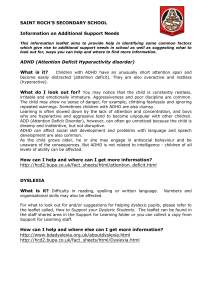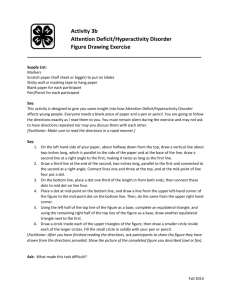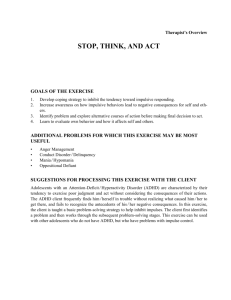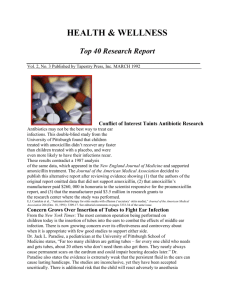Summer 2012 Issue - Goodwin Community Health
advertisement
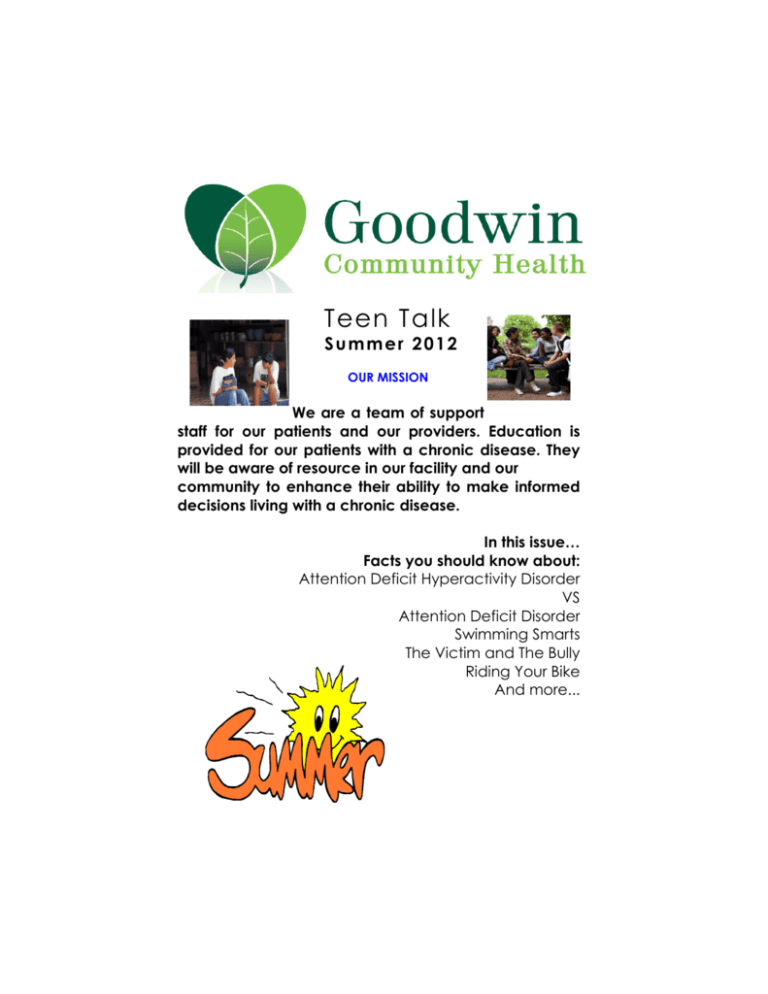
Teen Talk Summer 2012 OUR MISSION We are a team of support staff for our patients and our providers. Education is provided for our patients with a chronic disease. They will be aware of resource in our facility and our community to enhance their ability to make informed decisions living with a chronic disease. In this issue… Facts you should know about: Attention Deficit Hyperactivity Disorder VS Attention Deficit Disorder Swimming Smarts The Victim and The Bully Riding Your Bike And more... What Is Bullying? Bullying is when a person is picked on over and over again by an individual or group of people with more power, either in terms of physical strength or social standing. Two of the main reasons people are bullied is because of their social status or appearance. Teenage bullies pick on the peers they don’t think fit in, maybe because of how they look or act, their race or religion, because they think they might be gay or lesbian, or because they are shy and withdrawn. Some bullies attack their peers physically, whether it’s a shove, tripping, punching, or hitting, and even sexual assault (physical bullying). Other bullies use verbal insults and taunt or tease their targets (verbal bullying). Verbal bullying can also involve sending cruel and insulting instant messages or email or posting insults about a person on a website such as Facebook or Twitter (cyber bullying). Still others (especially if they are popular) use psychological control, excluding their victims from their group or clique because they see them as different (psychological bullying). Those being bullied are at risk of mental health problems, such as low self-esteem, stress, depression, 2 or anxiety. They may even think of suicide, and some follow through. How Does Bullying Make People Feel? Most people can take one episode of teasing or name calling, but bullying is relentless and can put a person in a state of constant fear. The victims health may suffer from the stress of bullying, including stomach pains, diarrhea, and irritable bowel syndrome. They may go hungry during school, afraid to go in the cafeteria for lunch, causing lack of concentration during class. They can also suffer from lack of sleep with all the added stress, making it hard to function at school, do well on tests or complete homework assignments in a timely manner. Common Signs That A Child I Bullying Others Children who bully tend to have: Average or above average self-esteem Impulsive personalities Lack of empathy or caring toward other people Difficulty conforming to rules Positive attitudes toward violence Bullies can be outgoing and aggressive, or can appear reserved on the surface but manipulate 3 others in subtle, deceptive ways. They like to dominate others and are generally focused on themselves. They often have poor social skills and poor social judgment. Most bullies think they are hot stuff and have the right to push people around, while others may be insecure. They put other people down to make themselves feel more interesting and powerful. Some bullies are quite popular, and they enjoy high status and esteem from their peers and even teachers. They are called Hidden Bullies, popular teens who exhibit aggression including persistent arguing, fighting, and getting in trouble in school and at home. Bullies are at risk of problems too, as their bullying often leads to more violent behavior as they grow up. It is estimated that 60% of school bullies will have a criminal record by the time they are 24. Some teen bullies end up being rejected by their peers and lose friendships as they grow older. They can also fail in school and not have the career or relationship success that others enjoy. If you find it hard to resist bullying someone, talk to someone you look up to, and try to think about how others feel when you tease and hurt them. Bullying makes everyone feel miserable, even the bullies. People might feel intimidated by bullies but they 4 don’t respect them. If you want others to look up to you as a leader, find a positive way to use your power, rather than to put others down. You really don’t want others to think of you as unkind, abusive and mean. It’s never too late to change. What Can You Do To Protect Yourself If You Are Being Bullied? Report bullying if it threatens to lead to physical danger and harm. If the bullying situation could escalate to physical violence, try to avoid being alone, walking with friends to and from school. Stick close to friends or classmates during the times the bullying takes place. Ignore the bully and walk away. Remember, bullies thrive on the reaction they get, and by ignoring them or walking away you are telling them you don’t care. Hold the anger, that way they don’t have control over your emotions. If you are in a situation where you have to deal with a bully and you can’t walk away, use humor to throw the bully off guard. Work out your anger by exercising or writing down your feelings instead. Aggressive responses tend to lead to more violence and more bullying for the victim. Practice confidence - Ways to respond to the bul- ly verbally or through your behavior. Practice 5 feeling good about yourself, even if you have to fake it at first. Take charge of your life - Think of ways to feel your best and strongest, so that the other kids give up the teasing. Exercise is one way to feel strong. Learn a martial art, or take a yoga class, or gain confidence in something like chess, art, computers or writing. Join a class, club, or gym and make new friends. The confidence you gain will help you ignore the mean kids. Talk to your parents, guidance counselor, teacher, and friends - anyone who can give you support. Talking is a good outlet for fears and frustrations that tend to build when you are being bullied. Bicycle Safety Every year about 300,000 kids go to emergency rooms across the country because of injuries on their bikes, and at least 10,000 kids require a few days in the hospital due to their injuries. Some injuries are so serious that kids die, usually due to head injuries. Tips For Being Safe On The Road Ride a bike that is the right size for you. When you stand straddling the top bar on your bike, and with your feet flat on the ground, there should be 1-3 inches of space between you and the top bar. Wear a bike helmet that fits you properly. You 6 don’t want it too small or too big. Make sure you don’t wear a hat under your helmet. Wear your helmet level and cover your forehead. Don’t tip it back so your forehead is showing. Also the straps should be fastened at all times, and that the straps are snug enough so you can’t pull or twist the helmet around on your head. Wear your bike helmet any time you go for a ride, even if it is for a short distance. Better safe than sorry! Wear bright clothing, and make sure nothing is hanging, such as loose pant legs, shoelaces or backpack straps, as they can get stuck in the chain and pedals of your bike. Wear the right shoes. Sneakers are good, but avoid sandals, flip-flops, heels and cleats. They don’t grip the pedals. NEVER go riding barefoot! Put reflectors on your bike so other people can see you, especially if you are riding at dusk or after dark. Keep your eyes on the road ahead to avoid falling. Wet leaves, puddles, gravel and rocks, curbs, and changes in the road or sidewalk surface are all hazards. Always bring water with you if you are going on a long trip, so you don’t get dehydrated. 7 Keeping Your Bike In Tip Top Shape Make sure your seat, handlebars and wheels fit tightly. Check and oil your chain regularly. Check your brakes to make sure they work well and aren’t sticking. Check the tire pressure in your tires to make sure they have enough air, and the right amount of air. Obey The Rules Of The Road Ride with your hands on the handlebars at all times. Stop and check in both directions for traffic upon leaving your driveway, an alley, or a curb. Cross at intersections and walk your bike across, using the crosswalk following the traffic signals. Ride on the right-hand side of the street, so you are going the same direction as the cars do. NEVER ride against traffic! Use bike lanes and designated routes when you can. Don’t ride too close to parked cars, as doors can open suddenly, and always keep your eyes out for cars and trucks on the road. 8 Stop at stop signs and always obey traffic lights. Ride single-file on the street when you are riding with friends. When passing other bikers or people on the street, always pass to their left. Always use hand signals. Hand Signals Left turn - Lift left arm straight out horizontally. Right turn - Lift left arm straight out horizontally to the elbow, then lift hand up so palm is facing to the front OR lift right hand out horizontally. Stop - Left arm out horizontally, then drop hand down so palm is facing to the back. Attention Deficit Hyperactivity Disorder VS Attention Deficit Disorder Attention Deficit Hyperactivity Disorder or ADHD is a medical condition that affects how well someone can focus, pay attention, and sit still. ADHD begins in childhood, though sometimes it’s not diagnosed until much later in teen years, and sometimes not until adulthood. People with ADHD have trouble focusing on certain tasks and subjects because they have differences in 9 the parts of the brain that control attention and activity. They may seem impulsive, “wired” and often get into trouble because of it. ADHD can show up in different ways in different people. Here are some of the signs of ADHD: Has difficulty paying attention and staying focused on a task or activity. Has trouble focusing on instructions and difficulty following through. Has difficulty paying close attention to details or makes careless mistakes. Has problems finishing assignments or tasks at school and home and jumps from one activity to another. Easily distracted, even when it is something fun. Loses or forgets things such as homework. Has trouble organizing tasks and activities. Has difficulty waiting one’s turn. Blurts out answers before questions have been completed. Interrupts or intrudes on other people. Fidgets with hands or feet or squirms in their seat. Feels restless and often talks excessively and has trouble engaging in activities quietly. 10 People with ADHD have so much trouble staying focused and being able to control their behavior, that it affects their emotions and how well they do in school and in all aspects of their lives. It interferes in their ability to study and learn like other kids. As they grow older, people with ADHD may outgrow it but more than half who have ADHD as a child will continue to show signs of the condition as young adults. Sometimes the symptoms of ADHD become less severe as the child gets older. The hyperactivity part of the disorder can diminish with age, although the problem of staying focused, their lack of being able to focus and pay attention, and their lack of organizational skills often remain. Attention Deficit Disorder Attention Deficit Disorder (ADD) is used to describe a type of ADHD that doesn’t involve hyperactivity. The child with Attention Deficit Disorder has all the same problems as the child with ADHD, except for the hyperactivity aspect, and the impulsive issues that stem from it. 11 Here are some of the signs of Attention Deficit Disorder: Has difficulty paying attention and staying focused on a task or activity. Has trouble focusing on instructions and difficulty following through. Has difficulty paying close attention to details or makes careless mistakes. Has problems finishing assignments or tasks at school. Easily distracted, especially when it is noisy. Loses or forgets things such as homework. Has trouble organizing tasks and activities. Though those with Attention Deficit Disorder (ADD) don’t have the hyperactivity aspect of ADHD, they still have trouble staying focused and being able to complete tasks at home and school, and it affects how well they do in school and in all aspects of their lives as well. It also interferes in their ability to study and learn like other kids. What Causes ADHD and ADD? Though it’s not exactly clear why some people have ADHD/ADD, research shows that it is probably genetic and it may be inherited in some cases. Scientists have 12 also found that it is prevalent in children who are born prematurely and is more commonly diagnosed in boys than it is in girls. It is known that ADHD and ADD is caused by changes in brain chemicals called neurotransmitters. These chemicals help send messages between nerve cells in the brain. The neurotransmitter Dopamine stimulates the brain’s attention centers. So a person with low amounts of this chemical may show symptoms of ADHD and ADD. How Is ADHD/ADD treated? Because some people have more trouble with the attention side of the disorder and others have more problems with the activity side, doctors gear their treatment to the person’s symptoms so different people may have different treatments. Doctors usually follow a multimodal (pronounced: mul-tee-moe-dul) approach for treatment. This means they use several different treatment methods for one patient, such as medication, family and individual counseling, and changes at school to address particular learning styles. Medications help both those with ADHD/ADD by improving their focus and attention and reducing the hyperactivity in those with ADHD. The medication used today is taken at home once a day in the morning. Family counseling helps treat ADHD/ADD because it keeps the parents informed and shows them ways to work with their kids that will help them. It also helps improve communication within the family and solves 13 problems that come up between teens and parents at home. Individual counseling helps the teens to better understand their behavior and helps them to learn new coping skills. Sometimes teens work together in group therapy, which helps them work on coping skills and interacting with others, if that has been an issue in the past. Schools are also involved in helping the student with ADHD/ADD. Most will develop a plan that is right for each teen, and they will make changes that allow them to learn in ways that work best for them. People with ADHD/ADD may also have other problems such as depression, anxiety, or learning disabilities like dyslexia, that requires treatment. They may also be at greater risk for smoking and using drugs, especially if they are not appropriately diagnosed and treated. ~Tips To Try ~ Sit in the front of the classroom to limit distractions Turn off email, instant messaging and your phone when doing homework or other tasks, to help stay focused. Talk with your teacher about your ADHD/ADD and work together to make sure you are learning in a way that best works for you. Some teens may benefit from smaller class sizes and tutorial help, or studying in a quiet place. 14 Use tools that will help you stay organized. Keep track of assignments in a notebook, including a list of books and readings you’ll need to bring home to do them. Write down classes and other appointments in a daily planner or notebook, so you don’t forget. For those with hyperactivity, exercise. It can help you when feeling hyper during school. Talk to the teacher about taking activity breaks so you can stay focused and concentrate better in class. Take frequent activity breaks while studying or doing homework too, if needed. Practice relaxation and meditation techniques to help you relax and focus. Let friends know what’s going on, so they understand your impulsive behaviors, and apologize if you have hurt someone’s feelings and try to be careful in new situations. Most importantly take pride in the things you do well. Having ADHD/ADD is just a different way of being, and people who have it have their own abilities and talents. Learn as much as you can about ADHD/ADD so you can find the methods that work best for you, so you can reach your full potential both academically and socially. 15 Trivia ~ 1900-1910 Kellogg’s Toasted Corn Flakes, Grape-Nuts and Quaker Oat were staples in everyone’s household in the 1900’s. Hellman’s Blue Ribbon Mayonnaise, Morton Salt, and Crisco were first introduced at this decade too. Wages - Child in textile mill… $3.54/week. Meat Packer… $9.50/week, Housekeeper... $5.00/week. In the 1910’s cigarette smokers were definitely in the minority when it came to tobacco use. Upper class people smoked pipes or cigars, while the less refined men favored chewing tobacco. In the early 1900’s boys played marbles, and if there was a manhole cover nearby, the dips in them were used as gullies. The boys would flip their marble with their first finger against their thumb and fore if they got a marble into a gully. Boys were proud of their marble collections and would swap among themselves to get a range of sizes and colors. Some of the marbles were very pretty. They were made of glass with a twisted color markings inside. One of the girls favorite games was skipping rope, either by themselves holding an end of a rope in each hand, or in a group where the ends of a 16 longer rope were held by two different people, one at each end. Any number of children could come in and skip together and some times tried to see how many they could do before some one stumbled over the rope and stopped it. Sometimes they would play at "calling in" a particular child by name and they would vary the speed of the rope so that the child doing the jumping had to jump faster or in some sort of fancy manner. Hopscotch was very popular during this time too. There were many variations of this game, with different rules about what to do at each slab. The chalk quickly rubbed off or was washed off by the rain. At the high school level, students were being guided into academic and vocational tracks. Classes in ethics, health, family life and job skills were also being added to the lineup. At the turn of the century, 34% of city children left for school with little or no breakfast. Most likely an equal number of children couldn’t afford a proper lunch. Rose O’Neill created the Kewpie doll in 1909. In 1913, an item called the Erector Set was invented. It was a steel, motorized toy that children could use to build models of just about anything. AC Gilbert, a medical doctor, was the creator. In 1901 only 11.4% of teens between the ages of 14 -17 were in high school. The number increased to 17 15.4 % by 1910. In 1900, one out of every five kids between the ages of 10-15 was employed. Some of the jobs were sewing, making cigars, running errands for neighborhood shops. Some worked in glass factories, textile mills, and mines, while still others worked in the fields or on the farm, where they picked tobacco etc. The first Pizzeria in America was in New York city. They called it Lombardi’s. Wilbur and Orville Wright made the first airplane flight from Kitty Hawk, NC in 1903. Henry Ford built the first automobile that members of the general public could afford, naming it the Model T. It was introduced in 1900 for $850.00. Swimming Smarts Summer is right around the corner and when the weather gets hot, everyone wants to be in or around water. Hanging at the pool, beach, lake, or pond is a great way to beat the heat. Most kids don’t think much about water safety, but they should. For people ages 5-24, drowning is the second leading cause of accidental death! Most water related accidents can be avoided by knowing how to stay safe and following a few simple rules. Learning how to swim is essential if you plan to 18 be in or around the water. Swimming instructors always tell their students: Swim with a partner. Whether it’s in the pool or in a lake, even the best swimmers get tired, and sometimes get muscle cramps, which can be dangerous if you are over your head when it happens, or to even get out of the water by yourself when it is happening. If a friend is nearby, they can help you get to shore, out of the water, or go for help in case of an emergency. Be prepared. Learn some life-saving skills such as CPR, and rescue techniques. It could help save a life! Check your local YMCA or YWCA, chapter of the Red Cross or your local hospital to see if they offer free classes. They usually have them for beginning and experienced swimmers and boaters somewhere in the community. Swimming lesson provide you with tips on handling unexpected hazards in and around water. If your just learning how to swim, don’t go over your head, and don’t try to keep up with more experienced swimmers. If you’re a good swimmer and have had lessons, keep a watchful eye on your friends, who may not swim as well as you do. If it appears that you or your friend(s) are getting tired, suggest taking a break from swimming. Swim only in areas that have a lifeguard. You never know when there will be changes in ocean currents, 19 rip currents, a sudden storm or other hidden dangers. If something should happen, the lifeguards are trained in rescue techniques. Swimming in an open body of water is different than swimming in a pool, and you need more energy to handle the currents, waves and other changing conditions in the open water. If you find yourself caught in a current or riptide, it is important not to panic or fight the current. Try to swim sideways, parallel to the shore until you get out of the current, which is usually a narrow channel of water. Gradually make your way back to shore. If you are not able to get away from the current, stay calm and float with the current. It will usually slow down, and then you can swim to shore. Be careful about diving. Diving injuries can cause permanent spinal cord damage, paralysis and sometimes death. Watch the sun. Sun reflects off the water and intensifies the burning rays. You won’t feel sunburned, but the pain from the sunburn will catch up with you l later. Reapply sunscreen frequently and cover up when you can. Don’t forget your hat, UV protective sunglasses and protective clothing. Drink plenty of fluids to stay hydrated. Dehydration causes dizziness, nausea, overheating and cramps in your legs. Never drink alcohol while swimming. Half of all adolescent male drownings are tied to alcohol use! 20
